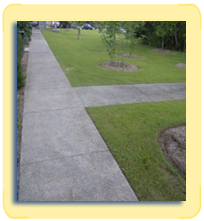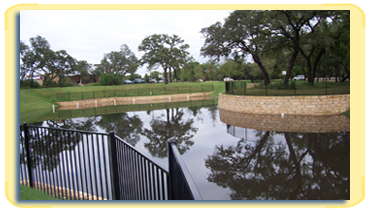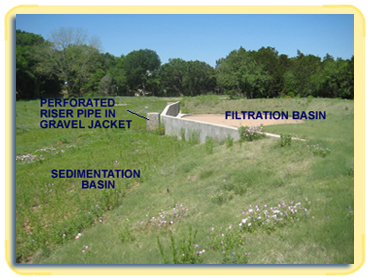Using physical and biological treatment mechanisms, biofiltration uses an organic filtration media with vegetation to remove pollutants. As with sedimentation/filtration systems, runoff is first diverted into a sedimentation basin, where particulate pollutants are removed via gravity settling. This is followed by filtration through an 18" layer of vegetated media.
Biofiltration systems are considered to provide a level of treatment equivalent to sedimentation/filtration, and also provide extended detention that enhances baseflow and reduces stream erosion. Biofiltration systems are not allowed in Barton Springs Zone (BSZ) watersheds as a stand-alone water quality control, as they are not capable of achieving a non-degradation level of treatment.
Because of the vegetation, biofiltration systems can be aesthetic amenities and may be eligible for landscape credit (unlike sedimentation/filtration systems). To ensure proper management of the pond system, filtration media, and vegetation, an Integrated Pest Management (IPM) Plan is required.
The current design criteria is similar to that for sedimentation/filtration systems, and two design alternatives are available. In “full” sedimentation/filtration systems the entire water quality volume is held in the sedimentation basin, which then slowly discharges runoff to the filtration basin via a perforated riser pipe. The alternative “partial” sedimentation/filtration design foregoes the perforated riser pipe, and distributes the water quality volume between the filtration basin and a sediment chamber, the latter separated from the filtration bed by a vegetated hedgerow. The “full” design is required when the City of Austin is responsible for maintenance.
Design guidelines for biofiltration can be found in Section 1.6.7.C of the Environmental Criteria Manual. For information on the biofiltration media, go to biofiltration media guidance. Also available is a list of potential suppliers.

Below is a list Biofiltration Media Suppliers that we are aware of.
Organics "By Gosh"
Sherry Williams
Wholesale Bulk
Account Executive
512-872-1434
Organics "By Gosh"
2040 FM 969
Elgin, TX 78621
sherry@organicsbygosh.com
- Non-Structural Controls are Best Management Practices (BMPs) that do not involve a structured, or engineered solution. They include such measures as education, site planning, and stormwater management regulations. Because it is usually easier and more effective to prevent pollution before it occurs, non structural BMPs are very cost-effective. These measures limit or eliminate pollutants before they end up in the stormwater.
- Non-structural controls include: non-required vegetation, vegetated filter disconnect, integrated pest management, and regulations.
Porous Pavement includes a load-bearing, durable concrete surface together with an underlying layered structure that temporarily stores water prior to infiltration. Porous Pavement is a water quality control best management practice (BMP) using the storage within the underlying structure or sub-base to provide groundwater recharge and to reduce pollutants in stormwater runoff.
To ensure proper functioning of porous pavement, no off-site runoff is allowed and proper subgrade conditions must exist.
Porous pavement is currently only allowed for pedestrian use and not for parking lots, stormwater hot spots, or areas where land use or activities generate highly contaminated runoff. Since porous pavement is an infiltration practice, it should not be applied at stormwater hot spots due to the potential for ground water contamination.
Environmental Criteria Manual 1.6.7.E of the Environmental Criteria Manual

Rooftops can generate large volumes of runoff which, when discharged to paved surfaces and landscaped areas, can generate large pollutant loads. Rainwater harvesting systems can capture this runoff before it is discharged, thus preventing pollution while also putting the captured water to beneficial use, such as landscape irrigation or cooling water.
Rainwater harvesting is eligible for water quality credit only for commercial development. The amount of credit will depend on the size (water quality volume) and drawdown time of the system. Rainwater harvesting systems can provide equivalent treatment to a sedimentation/filtration system, or be designed to meet a non-degradation level of treatment required in Barton Springs Zone watersheds. An Integrated Pest Management (IPM) Plan is required if the captured rainwater is applied to vegetation.
Design guidelines for rainwater harvesting can be found in Section 1.6.7.D of the Environmental Criteria Manual.
The Water Conservation staff of the City of Austin Water Utility is available to provide input on how to achieve cost-efficient design and equipment selection that will also help reduce water and wastewater costs.

Under the SOS regulations, certain watersheds in Austin allow no increase in pollutant load to receiving streams. Retention irrigation ponds capture stormwater in a holding pond and use the captured volume for irrigation of the surrounding landscaped areas rather than allowing direct release to receiving streams. There is virtually no discharge of runoff off-site and it mimics the undeveloped watershed conditions by allowing infiltration of smaller rainfalls. Retention irrigation systems have excellent pollutant removal efficiency.
Environmental Criteria Manual 1.6.9 (Guidance for Compliance with Technical Requirements of the SOS Ordinance)

Sedimentation/Filtration systems are the primary stormwater treatment device used in Austin. Runoff is first diverted into a sedimentation basin, where particulate pollutants are removed via gravity settling, followed by filtration through an 18” layer of sand. These systems can achieve removal rates of 40-90% for suspended solids, heavy metals, and organics. Properly operating systems will typically capture 90% or more of all runoff from the contributing drainage area, and release it at a slow rate that enhances baseflow and reduces stream erosion.
Sedimentation/filtration systems are not allowed in Barton Springs Zone (BSZ)watersheds as a stand-alone water quality control, as they are not capable of achieving a non-degradation level of treatment.

Two design variations are allowed in Austin. In “full” sedimentation/filtration systems the entire water quality volume is held in the sedimentation basin, which then slowly discharges runoff to the filtration basin via a perforated riser pipe. The alternative “partial” sedimentation/filtration design foregoes the perforated riser pipe, and distributes the water quality volume between the filtration basin and a sediment chamber. The latter is then separated from the filtration bed by a gabion wall or other porous structure. The “full” design is required when the City of Austin is responsible for maintenance.

Design guidelines for full and partial sedimentation/filtration ponds are provided in Section 1.6.5.of the Environmental Criteria Manual (see 1.6.5.A for “full” systems and 1.6.5.B for “partial” systems).
A vegetative filter strip is an innovative water quality control in which runoff is routed as sheet flow through a mildly sloped, well-vegetated area, thus promoting infiltration, sediment deposition, and filtration of pollutants. Because of the need to maintain sheet flow, filter strips are typically used to treat small drainage areas, or areas with low impervious cover. These treatment systems can be used in both Barton Springs Zone (BSZ) and non-BSZ watersheds, but those in BSZ watersheds must be larger. To maintain the proper functioning of these systems the vegetation must not be cut too short (minimum 3” for turfgrass and 18” for bunchgrass), grass clippings must be removed out of the filter strip, and an Integrated Pest Management (IPM) plan is required. Design guidelines for vegetated filter strips are provided in the Environmental Criteria Manual (Section 1.6.7 Alternative Water Quality Controls)

